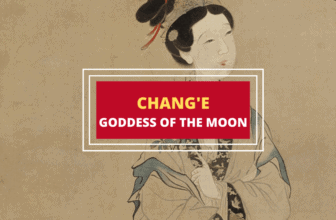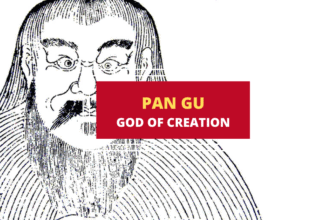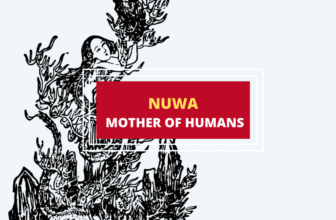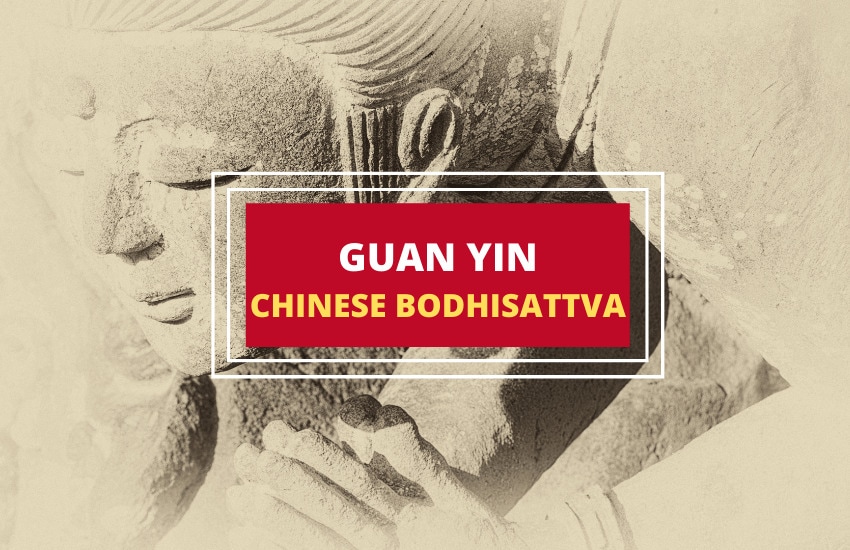
Table of Contents
Guan Yin, also known as Kuan Yin or Guanshiyin, is associated with Avalokiteśvara – the embodiment of compassion in Mahayana Buddhism, who is considered a bodhisattva on the path to becoming a Buddha. In that sense, Guan Yin is both a person who is believed to have lived a long time ago, as well as an aspect of divinity and the Universe. The Chinese name literally translates as [The One Who] Perceives the Sounds of the World, while Avalokiteśvara translates as Lord who Gazes down on the World.
Guan Yin Depictions Chinese Iconography
This key figure in Buddhism and Chinese mythology is present in countless temples and works of art. Guan Yin is usually depicted as a woman, although various myths say that she can take the form of any living being and can be both male and female.
Guan Yin is typically shown in white robes that are often loose and open at the chest. She often has a crown with an ornament in the of shape Buddha Amitabha, Guan Yin’s teacher and one of the five Cosmic Buddhas of Esoteric Buddhism.
Guan Yin is frequently shown carrying a vase in her left hand that she often pours water from, symbolizing good fortune. In her right hand, she often carries a willow branch, a lotus bloom, a fly whisk, rice sheaves, or a fish basket.
She is also often shown standing on a dragon that’s swimming in the sea or riding a Qilin – a mythical riding animal that symbolizes the avoidance of causing harm as well as the punishment of the wicked.
Guan Yin as Miao Shan – Origins
The stories of Guan Yin’s origins depict her as an atypical girl of her time, demonstrated her courage, bravery, compassion, and love for all beings despite the wrongs done to her.
Not a Typical Girl
Guan Yin was born as Miao Shan (妙善). Right from the start, there was something special about Miao Shan that made her different to the other girls of her age: she began to chant Buddhist sutras without any instruction as soon as she could speak.
As she grew up, Miao Shan showed great capacity for compassion, going even so far as to refuse to get married to the man of her father’s choice, unless the marriage would help solve three universal issues:
- The suffering of sickness
- The suffering of age
- The suffering of death
As her father couldn’t find a man who could help alleviate these issues, he gave up trying to marry her off and instead allowed her to become a Buddhist nun, taking leave on her religious vocation.
Miao Shan at the Temple
King Zhuang wanted Miao Shan to become discouraged, and secretly asked the Buddhist monks of the temple to allocate the hardest, most back-breaking work to Miao Shan. Without complaint, Miao Shan entered wholeheartedly into her tasks.
Because of Miao Shan’s kindness and empathy for all living creatures, she was helped by the forest animals that lived near the temple to complete her tasks, as well as by other greater powers.
This infuriated her father to such an extent, that he then burned down the temple, in an attempt to dissuade her and prove her wrong, but Miao Shan was able to stop the fire easily and without help, using her bare hands, a miracle which saved herself and the other nuns.
Miao Shan is Executed
Now things took a darker turn. Her father ordered her execution, as he believed that Miao Shan was under the influence of a demon or evil spirit. He saw no other way out, than to have her killed, but gave her one last chance to marry and live a normal wife as a typical woman of the times. However, Miao Shan refused, remaining steadfast. She was then ordered to be killed.
However, in a twist, the executioner wasn’t able to execute Miao Shan, as every weapon he used against her was shattered or rendered ineffective. Finally, Miao Shan felt pity for the executioner, seeing how stressed he was becoming as he wasn’t able to follow his king’s orders. She then allowed herself to be executed, absolving the executioner of his negative karma that he would acquire by killing her. Miao Shan died and went to the afterlife.
An alternative version of the story of Guan Yin’s origins state that she never died at the hands of the executioner but was instead spirited away by a supernatural tiger and taken to Fragrant Mountain, where she became a deity.
Miao Shan in the Realms of Hell
Miao Shan was guilty of having absorbed the karma of the executioner, and so was sent into the realms of Hell. As she walked through Hell, flowers bloomed around her. However, Miao Shan witnessed the terrible suffering of those in Hell, which caused her to be overcome with grief and compassion.
She decided to release all the merit she had accumulated over her many lifetimes, through all the good things she had done. This freed many of the suffering souls in Hell and allowed them to either return to Earth or ascend to Heaven, where their suffering ceased. This changed Hell, turning it into a Heaven-like land.
The King of Hell, Yanluo, aghast at the destruction of his land, had Miao Shan sent back to Earth, where she lived on Fragrant Mountain.
Miao Shan’s Great Sacrifice
The story of Miao Shan has one other instalment, which demonstrates her capacity of compassion. Miao Shan’s father, who had wronged her and had her executed, had fallen ill and was dying of jaundice. No physician or healer was able to help him, and he suffered greatly.
However, a monk foretold that a special medicine made of the eye and arm of one without anger would save the king. The royal family wondered where they could find such a person, but the monk directed them to Fragrant Mountain.
They journeyed to Fragrant Mountain, where they encountered Miao Shan and requested her eye and arm to save the king’s life. Miao Shan gladly gave up her body parts.
After he recovered, the king journeyed to Fragrant Mountain, to thank the unknown person who had made such a great sacrifice. On finding that it was his own daughter, Miao Shan, he was overcome with grief and remorse, and begged her for forgiveness.
Miao Shan’s selflessness transformed her into a bodhisattva, or enlightened one, known as Guan Yin.
What is a Bodhisattva?
In Buddhism, whether Chinese, Tibetan, Japanese, or any other branch, a bodhisattva is a person who is on their path to reaching Enlightenment and becoming a Buddha. In other words, a bodhisattva is as much a state of being as it is a person.
As the bodhisattva of compassion, Guan Yin is one of the most central divinities in Buddhism – she is an integral step for reaching Enlightenment as that’s impossible without compassion.
Guan Yin / Avalokiteśvara in the Lotus Sūtra
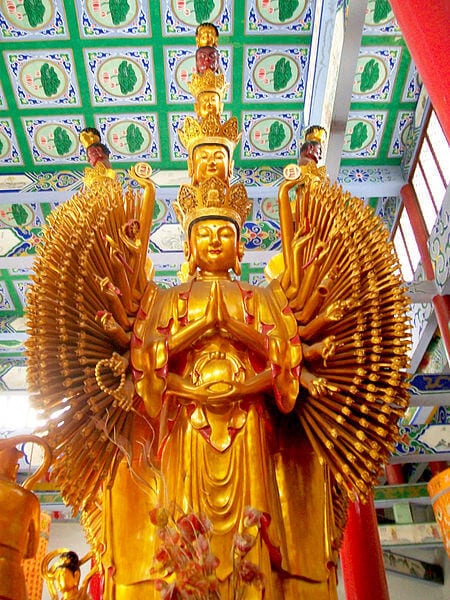
This bodhisattva is present in one of the earliest Sanskrit holy texts, the Lotus Sūtra. There, Avalokiteśvara is described as a compassionate bodhisattva who spends her days listening for the cries of all sentient beings and who works day and night to help them. She is depicted as having a thousand arms and a thousand eyes.
In the Lotus Sūtra, Avalokiteśvara/Guan Yin is even said to be able to take the form of or inhabit the bodies of anyone, including other gods such as Brahma and Indra, any Buddha, any Heavenly Guardian such as Vaisravana and Vajrapani, any king or ruler, as well as any sex or gender, people of any age, and any animal.
The Goddess of Mercy
Guan Yin was given the moniker “The Goddess of Mercy” by the first Jesuit missionaries who traversed China. As they came from the West and followed their monotheistic Abrahamic religion, they couldn’t fully comprehend the exact nature of Guan Yin as both a mythological figure, a state of mind, and a divinity.
In their defense, however, many of the Chinese and other Eastern myths do depict Guan Yin as a traditional polytheist deity. For example, some Buddhists believe that when a person dies, Guan Yin places them or their souls in the heart of a lotus flower and sends them to the mythical Pure Land of Sukhāvatī, a paradise of Mahayana Buddhism.
Symbolism and Meaning of Guan Yin
Guan Yin’s symbolism is as clear as it is core to both Buddhism and most Eastern cultures and traditions.
Compassion is a key component of getting in tune with the divine nature of the Universe for not only Buddhism but also for Taoism and Chinese mythology and culture as a whole.
This is a large reason why Guan Yin is so popular and why her statues, depictions, and myths can be found everywhere in China and the rest of East Asia.
In China, Guan Yin is also associated with vegetarianism, due to her compassion for all animals.
Compassion is often associated with femininity, which is another aspect represented by Guan Yin. As a woman, she is depicted as brave, strong, independent, and fearless, while at the same time being compassionate, gentle, selfless, and empathetic.
Importance of Guan Yin in Modern Culture
Guan Yin’s influences stretch far beyond the ancient Chinese and Asian religions. She, versions of her, or other characters that have clearly been inspired by her, can be seen in various works of fiction to this day.
Some of the most recent and famous examples include the Kwannon character from the Marvel X-Men comic book series, Kuan Yin from the Spawn comic book series, as well as many of Richard Parks’ books such as A Garden in Hell (2006), The White Bone Fan (2009), The Heavenly Fox (2011), and All the Gates of Hell (2013).
Kwan Yin is also mentioned in Alanis Morissette’s song Citizen of the Planet. In the popular anime Hunter x Hunter, the character Isaac Netero can summon a giant statue of Guanyin to attack his enemies. And, in the popular sci-fi TV show The Expanse, Guanshiyin is the name of Jules-Pierre Mao’s space yacht.




